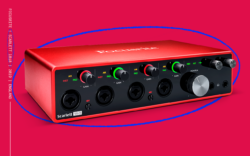Illustration: Lan Truong
By sending measured sound waves back out into the world, speakers have become one of the most essential pieces of modern technology.
Could you imagine not being able to listen to the radio on a long road trip, zone out to your favorite song on a pair of headphones, watch a new TV show, or even take a phone call? Human civilization over the past century-plus has become completely dependent on speakers to transmit sound and music—but how exactly do they work? In this article, we explore this simple-yet-effective technology that makes things loud.
Feel free to use the table of contents below to easily navigate to a specific topic.
What you’ll learn about speakers:
Let’s dive in!
How do speakers work?
Let’s begin with the fundamental question: how do speakers work?
If you read our previous article on how microphones capture sound, you might feel some déjà vu, because both microphones and speakers work by using something called a transducer. Simply put, a transducer is an electronic mechanism that takes in one type of energy and puts out a different type of energy.
While the electroacoustic transducer in a microphone measures incoming sound waves from the air and converts them into electrical signals, the transducer in a loudspeaker (also called the driver) takes those electrical signals and throws them right back into the air as bits of high and low pressure.
That’s right—a loudspeaker is essentially a microphone in reverse!
To get sound out of a speaker’s driver, you first need to connect it to a source of electrical signals (like an amplifier, computer, or musical instrument) using the appropriate set of audio cables.
The speaker can now receive these signals and pass them through a wire-wrapped cylinder called a voice coil, which moves freely back and forth between the two poles of a larger surrounding magnet. Attached to the voice coil is the circular cone, which has an airtight suspension system on either side to keep it under control.
The resulting “push and pull” movement of the cone creates changes in air pressure that move outward from the speaker, which we interpret as sound. Most speakers are enclosed within a cabinet, which helps keep the focus on just the sound waves coming out of the front of the speaker.
The history of loudspeakers
The first speakers can actually be found in early telephone designs from Johan Philipp Reis in 1861. In subsequent decades, they were expanded upon by the likes of Alexander Graham Bell, Ernst Siemens, and Thomas Edison.
However, it took until the early 20th century for the now-ubiquitous moving coil system to really become established. First invented by Oliver Lodge in 1898, the design was successfully patented in 1925 by Edward W. Kellogg and Chester W. Rice, forming the basic principle for almost all speakers in use today.
Things started to really take off in the 1930s as manufacturers sought to improve aspects like overall power and frequency response in the context of movie theaters and large PA systems. Other advancements in the 20th century included systems with multiple drivers for different frequency ranges, design standardization, and better materials for components like the driver cone, magnet, and enclosure.
The wide world of speakers: 7 key concepts you’ll want to know
Today, speakers can be found literally everywhere in all sorts of different shapes and sizes, from the tiny drivers in your smartphone and earphones to the massive multi-speaker setups for sound reinforcement in stadiums and other performance venues.
As you dive deeper into the wide world of speakers, you might find yourself repeatedly encountering a number of commonly-used terms. Here’s a quick rundown of seven particularly key concepts and what they mean.
1. Full-Range Speaker
A full-range speaker is a loudspeaker that reproduces as much of the human-audible frequency spectrum as possible with just a single voice coil and driver.
2. Woofers and tweeters
Woofers and subwoofers are specialized drivers that reproduce lower-frequency sounds. On the other hand, tweeters specifically reproduce higher-frequency sounds.
3. Driver Size
The driver size is a measurement that describes the diameter of a speaker driver. Earphone drivers are usually between 8 mm – 15 mm, while headphone drivers are usually between 20 mm – 50 mm. Subwoofers for home setups are the largest, at around eight or more inches (lower frequencies mean bigger drivers). Meanwhile, mid-range woofers are usually a few inches in diameter, and tweeters are around an inch or less.
4. Crossover network
In a speaker system with multiple drivers, the crossover network is a set of filters that divide incoming audio into multiple frequency bands and send each one to the most appropriate driver. Low frequencies go to the woofers, while high frequencies go to the tweeters. Some setups even let you adjust the crossover frequency between a subwoofer and the higher-range speakers.
5. Active vs. passive
Active (or powered) speakers require a source of electricity to power their internal built-in amplifiers. Meanwhile, passive speakers don’t require power, but do need to be connected to a standalone amplifier or receiver in order to make sound.
6. Sound reinforcement system
A sound reinforcement system is a setup for effectively reproducing either live or pre-recorded sound in a large indoor or outdoor setting. Sound systems often include multiple sets of loudspeakers, as well as amplifiers, mixing consoles, signal processors, microphones, turntables, and other pro audio equipment.
7. Studio monitors
Studio monitors are loudspeakers that are specifically designed with professional music and audio production in mind. They’re called “monitors” because they reproduce audio signals much more accurately than other speakers, which is vital when recording, producing, editing, mixing, and mastering. Some studio monitors are categorized as near-field, which means they have smaller drivers and should be placed only a few feet away from your sitting position. This allows more direct sound to hit your ears, instead of unwanted reflections from the acoustics in your room.
Conclusion
Whether it’s for music production or general audio consumption, speakers have deeply embedded themselves into the lives of musicians and non-musicians alike. Hopefully this article gave you a deeper understanding about how they work, their history, and some common ideas that relate to them.
Do you have any questions about loudspeakers? Are there any fun speaker terms we missed? Start a conversation with us and other music creators in the Splice Discord.
Explore royalty-free one-shots, loops, FX, MIDI, and presets from leading artists, producers, and sound designers:
June 18, 2022

.svg)
.svg)




